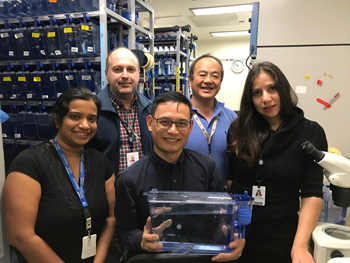Research connects gene defect to muscle and heart disease and identifies potential treatment

By Ana Gajic

Dr. Xiao-Yan Wen (centre) and his team at the Zebrafish Centre for Advanced Drug Discovery of St. Michael’s.
An international collaboration co-led by St. Michael’s Hospital, the BC Children’s Hospital, the University of Montreal, and the Radboud University Medical Center in the Netherlands has identified that a rare disease gene called NPL (N-acetylneuraminate pyruvate lyase) is responsible for muscle and heart diseases. This work was published in the prestigious journal JCI Insight.
“This work was made possible through the collaboration of many experts from around the world,” said Dr. Xiao-Yan Wen, director of the Zebrafish Centre for Advanced Drug Discovery at St. Michael’s.
Dr. Clara van Karnebeek, a pediatrician and biochemical geneticist at BC Children’s Hospital, and her colleagues at the Centre for Molecular Medicine and Therapeutics of the University of British Columbia, identified one family with heart disease and neuromuscular symptoms, as well as a marked increase in their sialic acid levels. Sialic acid is a sugar that helps cells to communicate with each other.
With a test called trio whole exome sequencing, which is used to identify the molecular basis of a genetic disorder, Dr. Maja Tarailo-Graovac identified mutations in the NPL gene of two siblings. Dr. Tarailo-Graovac is a researcher at the University of Calgary and an expert in high throughput sequencing approaches and their application for novel disease genes and genetic mechanism discoveries.
Since only one patient family with an NPL mutation was identified, the team searched for a match in various patient cohorts, and then went on to work with lab models to validate the effects of this very rare genetic mutation on a larger scale.
Dr. Wen, a world leader in zebrafish research, replicated the genetic make-up of the two siblings in the fish, and confirmed that an NPL gene deficiency in zebrafish resulted in muscle and heart problems, as it did in humans.
Importantly, his lab tested many disease treatment options by using various metabolites – molecules that are products of sialic acid metabolism – for NPL-deficient zebrafish. His team identified that specific sugar products formed from the NPL reaction – also known as monosaccharides ManNAc and GlcNAc – could potentially be used to treat this genetic disorder.
“First, this is a great discovery – no one had linked this gene to muscle myopathy before,” said Dr. Wen, who is also a scientist in Keenan Research Centre for Biomedical Science at St. Michael’s. “Second, it might mean better treatment options for NPL-deficient patients down the road.”
Dr. Dirk Lefeber leads the Radboud Center of Expertise on Disorders of Glycosylation in the Netherlands and is an expert in sugar metabolism defects. His team studied the sugar metabolites in patient cells and found a clear reduction of the NPL products in red blood cells, while normal levels were found in skin cells.
“This showed the importance of sialic acid breakdown for human muscle physiology and pointed to the right sugars that could be used for therapeutic studies,” said Dr. Lefeber.
Dr. Alexey Pshezhetsky is a researcher at the Sainte-Justine University Hospital Research Centre of the University of Montreal is an expert in sialic acid biology. His team established the effect of the identified mutations on the NPL enzyme. They are working on validating the results of this work in other lab models.
“Our preliminary data confirm that other models also show muscle weakness,” said Dr. Pshezhetsky.
Dr. Wen, Dr. van Karnebeek, Dr. Lefeber, Dr. Tarailo-Graovac and others have previously shown that sialic acid synthesis by a different enzyme is important for brain and skeletal development. This work was published in Nature Genetics two years ago. Taken together, the team’s studies demonstrate the importance of the metabolism of sialic acid, a simple sugar compound, in human health and diseases.
“For these discoveries, teamwork involving different disciplines with the patients as partners is essential,” said Dr. van Karnebeek, who is now a researcher at the Amsterdam University Medical Center. “We need to continue this work and ensure it has an impact on our patients through improved outcomes, earlier diagnoses and identification of potential treatment targets.”
About St. Michael’s Hospital
St. Michael’s Hospital provides compassionate care to all who enter its doors. The hospital also provides outstanding medical education to future health care professionals in more than 29 academic disciplines. Critical care and trauma, heart disease, neurosurgery, diabetes, cancer care, care of the homeless and global health are among the Hospital’s recognized areas of expertise. Through the Keenan Research Centre and the Li Ka Shing International Healthcare Education Centre, which make up the Li Ka Shing Knowledge Institute, research and education at St. Michael’s Hospital are recognized and make an impact around the world. Founded in 1892, the hospital is fully affiliated with the University of Toronto.
About Unity Health Toronto
Unity Health Toronto, comprised of Providence Healthcare, St. Joseph’s Health Centre and St. Michael’s Hospital, works to advance the health of everyone in our urban communities and beyond. Our health network serves patients, residents and clients across the full spectrum of care, spanning primary care, secondary community care, tertiary and quaternary care services to post-acute through rehabilitation, palliative care and long-term care, while investing in world-class research and education. For more information, visit www.unityhealth.to.
